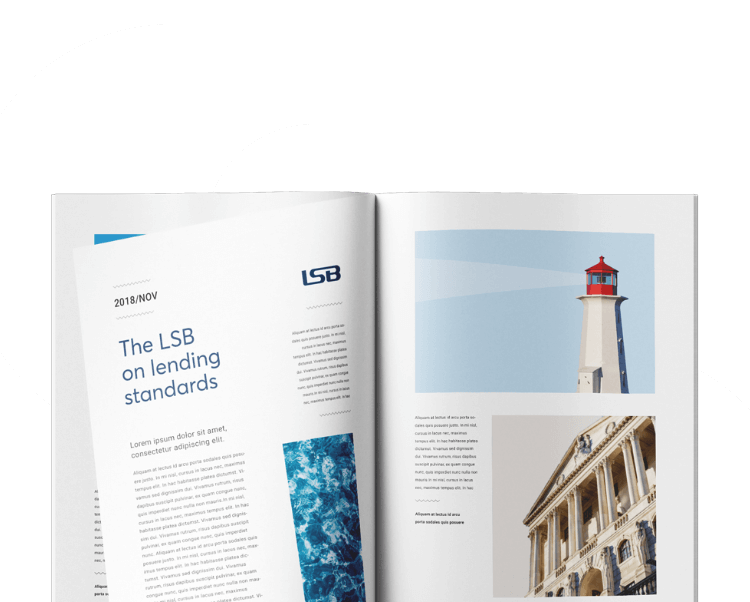Early in November, Emma Lovell was invited to speak at spoke at a Walker Morris event on alternative lending, the opportunities and potential risks this comes with, and how firms can mitigate those risks. Read her speech below.

*The notes below may differ from those delivered on the day*
Hello everyone, my name is Emma Lovell, and I’m Chief Executive of the Lending Standards Board – the LSB. I’m delighted to be here today to talk to you about alternative lending, the opportunities it brings, but also the potential risks that could arise from it and how they can be mitigated to ensure all business customers get a fair deal.
I’d like to start off by telling you a little more about the LSB and our role within the industry. We are the primary self-regulatory body for the banking and lending industry, with a goal of driving fair outcomes for customers of financial services. We do this through setting and overseeing best practice Standards and Codes that set the benchmark for good lending practice in the UK. They cover lending to personal and business customers with a turnover of up to 25 million, and we also oversee the CRM Code, which puts in place protections for customers from Authorised Push Payment scams.
Our registered firms comprise the major UK banks and lenders, credit card providers, debt collection agencies and debt purchase firms. Signing up to, and importantly, adhering to the Standards and Codes which sit within our remit, is a clear indication that a registered firm is committed to achieving good outcomes for customers. It’s prioritising those good customer outcomes in the alternative lending market that I’m going to focus on today.
The opportunities and risks of alternative lending
Alternative lending provides funds to businesses and individuals without having to go to a ‘traditional’ bank. Ranging from direct lending to peer-to-peer loans, embedded finance to Crowdfunding, alternative lending creates many opportunities for small businesses, but at the same time it can also present new risks.
The opportunities are clear – it has the potential to diversify finance, widen economic inclusion, increase choice, and it creates competition which could drive innovation across financial products and services. Yet the current lack of regulation and universal standards around the alternative lending market creates potential risks for bad outcomes for business customers.
To capitalize on the alternative lending opportunity, these organisations must be live to emerging risks and put in steps to reduce them for customers currently not considered by statutory regulation. Working in line with best practice standards provides the framework for alternative lenders to utilise new opportunities and innovate the lending market, whilst also protecting customers and offering a consistent standard of product and service delivery.
The importance of clear communications
One great advantage of the alternative lending market is the potential to speed up the process and increase the options for SMEs seeking initial or further borrowing. This is true for business customers of all sizes, from established firms with multiple credit lines, to those start-ups struggling to get approved by traditional lenders.
Yet although shorter application processes and less restrictions to accessing alternative finance in the short term may prove positive, they should not prevent lenders from providing clear and informative information to new customers about the products available, to ensure they can make a well-informed decision. Information should tell the customer about how the product or service meets their needs, what their borrowing obligations are, and the support available to them should they fall into financial difficulty. This information should be presented in an engaging, informative and consistent manner, regardless of the channel it is delivered through – website, post, or on a call for example.
The Standards of Lending Practice set the benchmark for business lending best practice in the UK, and drive consistency across the industry, ensuring customers receive a similar standard of service regardless of who their provider is. They require signatory firms to ‘ensure that customers are provided with clear and understandable information which enables them to decide whether the product they are considering applying for meets their needs and is appropriate for the type of business they are engaged in.’
By adopting a similar approach to best practice standards and clearly communicating information to customers, alternative lenders can ensure more consistency for customers, ensure they get the right product for them, understand their responsibilities (in relation to repaying for example), understand how they can access support if they need it, and ensure good outcomes can be achieved.
The customer journey
Take embedded finance as another example of where working towards best practice can ensure good outcomes for SMEs. This model gives companies the opportunity to offer financial products and services without the need for a banking licence, speeding things up for both the business and customer – by having seamless transactions taking place on one platform and removing often time-consuming processes like creating purchase orders or invoicing. But this fast form of financing does not come without its risks. Against a backdrop of increasing consumer appetite for instant, embedded finance, lenders will have to work to similar timetables with their products. This is where tracking the digital customer journey to ensure good outcomes don’t waver, will be key. Using quality assurance and oversight measures – not just to identify where things have gone wrong, but where things have worked well, and then sharing that knowledge with the wider organisation, can play a big part in producing good outcomes.
Tracking the customer journey as a whole is also vital. Carrying out quality assurance and oversight checks of one element of the customer journey in isolation may not raise a flag of any concerns, but with this lenders risk missing the bigger picture which could lead to bad outcomes. Having methods in place to track the entire customer journey, such as customer journey reviews, is an extremely valuable, holistic way for lenders to better understand areas for improvement across a variety of channels.
By putting in place these reviews and identifying areas where the policy, process, design, or delivery of the journey are not adequate, lenders can gain a better understanding of areas for improvement, build trust with their customers, and achieve good outcomes as a result.
Supporting SMEs in difficulty
And so what about those firms that are struggling, or are at risk of falling into financial difficulty – how can alternative lending benefit them, and what are the potential risks lenders should plan for?
Because although it may now feel like a thing of the past, the ripple effects of the pandemic will continue to affect individuals and businesses for many years to come. The rise in alternative lending models has been spurred on for this very reason, as a quarter of SMEs are now experiencing a cash flow crisis, three quarters are unable to access traditional finance, and 50,000 businesses are going insolvent annually due to cash flow problems – and to top that off, we are now in the middle of a cost-of-living crisis, the full impact of which is yet to be seen. There has therefore never been a more important time to support small businesses.
The difficulties facing many SMEs presents a major opportunity for the alternative lending market to step in and meet the needs of these customers, where traditional lenders cannot. Offering alternative forms of lending swiftly and with little friction can be a lifeline for struggling SMEs, yet lenders need to be prepared for how best to support customers in the pre-arrears stage. Good practice in this area is key to treating customers fairly as it can stop problems escalating by providing timely, proactive support. This can be achieved through a number of methods, such as proactively encouraging customers to reach out if their circumstances change and it may affect their ability to make repayments, putting in place measures to identify signs of difficulty and training staff to have proactive conversations when signs present themselves, and having appropriate governance structures and processes in place to signpost to third parties, including to turnaround specialists where required. Without proper governance, oversight and training, at-risk customers could slip under the radar or be inadequately signposted in a way that increases the risk to lender and business customers alike. Alternative lenders should therefore have policies, processes, and training that drives consistent best-practice, including when signposting firms to turnaround or other third-party help.
Getting a head start by working towards best practice standards
I hope the points I’ve raised today prove why it’s so important for lenders to act now without delay, and work towards best practice standards to produce good outcomes for their customers.
Recent research revealed that 45% of SMEs with plans to grow in the next 12 months are actually concerned about using alternative finance providers, partly due to fears over a lack of regulation. There are growing calls for FCA regulation to encompass the alternative lending market to increase protection for customers and businesses. But all lenders, regardless of size or offerings, should not rest on their laurels, and should instead consider working towards best practice frameworks now to keep pace with the latest trends and ensure the best outcome for their customers. Doing this will also stand lenders in good stead should statutory regulation be introduced further down the line, but should continue to adopt these approaches alongside it regardless – to raise the bar on base line standards.
You’ll know that the FCA recently introduced the Consumer Duty, requiring financial services firms to deliver good outcomes for vulnerable customers. Firms who are registered and adhere to our personal Standards are in a great position to comply with the Duty, due to already focusing on how they deliver good customer outcomes.
Working towards standards in this space would also incentivise and inform collaboration via the sharing of knowledge, expertise, and insights between regulators, traditional and challenger banks, and alternative lenders. This would ensure individual advances and learnings drive sector-wide progress whilst supporting better customer outcomes and building confidence and trust between customers and lenders, ensuring alternative finance delivers on its promise of democratising finance for all. Thank you.









